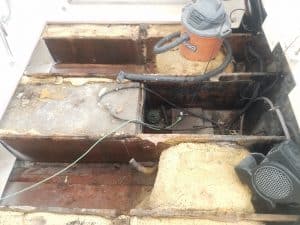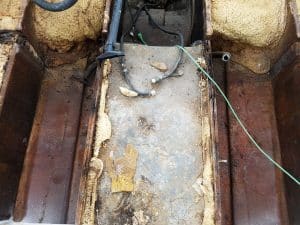Working in the Marine Industry and having restored a couple of boats personally, I have the privilege to see a lot of different failures that occur to boats over time. One of these common failures is when a boat’s fuel tank fails. Though there are many reasons for a fuel tank failing, eventually a new tank has to be put in. But, should it be foamed in?
Should I Foam Around My Boat Fuel Tank? Avoid foaming around a boat’s fuel tank if possible. When replacing a tank, have the tank secured in place with brackets or tabs screwed to the hull. Foam can hold water and eventually cause premature failure of the tank.
Here are a few of the many reasons you should avoid foaming around the fuel tank if at all possible.
Boat Fuel Tanks Fail and Need to Be Replaced
The average life span of a boat’s fuel tank ranges from 20-30 years. That is depending on the installation, material, and quality of the fuel tank.
There are other instances of where fuel tanks need to be replaced due to premature failure. There can be many causes.
A weld could crack and break. Something could be dropped under the fuel tank and rust a hole in the tank. Or, it can be punctured by a long screw through a bulk head!
Whatever the reason is, boat fuel tanks fail and need to be replaced at some point in a boat’s lifetime.
This process can become extremely time consuming and get pretty expensive, quickly! So understanding that this is a possibility, keep in mind the removal and installation process of replacing a boat’s fuel tank.
Why Were Boat Fuel Tanks Foamed in?
Most of the time, boat manufactures foamed in the fuel tanks to hold them in place. They would use a two part marine foam that would expand around the tank to keep it from banging around and cushion the tank to “prolong the life of the tank.”
Some manufactures even went to the lengths of pouring in the foam around the tank, and then placing the deck down onto the boat before the foam finished expanding!
Yes, this did cushion the tank and keep it in place, but at the same time, did it really add to the longevity of the fuel tanks lifespan?
Does Foaming Add to A Fuel Tanks Longevity?
There can be arguments to both sides of this question. But speaking from the experience that I have seen with 10 years in the marine industry, pulling up many decks and replacing many fuel tanks. I would say No.
In most cases the fuel tank compartment is sealed tight or even glassed in under the deck. At the same time, even though it is sealed, water still and will always find it’s way into the compartment.
Foam does not absorb water, leaving the water to sit around the tank and eventually rust or corrode it.
Though there are a few manufactures and cases where the foam did act as a sponge and just suck up and retain all of the water. However, for most cases, the water would just sit in between the foam and the tank.
The foam would act almost as a big bucket or bathtub retaining the water against the tank, actually speeding up the time in which it takes the water to corrode holes in the fuel tank!
This occurs even with the marine grade, two part, heavy duty, expensive foam! So, no, foaming around a tank does not add to a fuel tanks life span.
What About Epoxy Coating or Gluv-it?
The idea of taking an aluminum fuel tank and putting it into a boat bare, to most people seems like a very bad idea. Leading them to think that coating the tank with an epoxy type coating will help to add to the fuel tanks longevity.
We have a friend of ours that has been in the custom boat restoration and fiberglass business for over 40 years. His dad was working on boats using balsa core in the 50’s!
He has seen his share of fuel tank replacements and deck removals in his time in the industry. He says that there was a time when they were coating the tanks with epoxy.
Sanding the aluminum and scratching it up, cleaning it with chemicals, and then sealing it with the epoxy. What they found was that over the years, the epoxy would do the same thing as the foam would.
It would get blisters, cuts, scratches, or air pockets that would pop. Giving an entrance point for moisture.
The water would work it’s way under the epoxy and be trapped in between the epoxy and the tank. Creating the same premature corrosion issues on aluminum fuel tanks. With this discovery, they stopped coating their replacement tanks.
However, there are still many marina’s that coat their replacement tanks with Epoxy or Gluv-it, which isn’t necessarily wrong.
But, given the testimony from the custom boat restoration and fiberglass expert, I would say I believe his testimony and think that bare is the way to go.
So If You Don’t Foam the Tank, How Do You Install and Secure It?
Replacement tanks should be built to fit the location they are being put in. The best way to install a fuel tank and secure it is to have tabs welded onto the tank that can be secured to the stringers of the boat.
You want to make sure that they are fastened on at least four point of the tank. Depending on the length of the tank, six points is even better.
If you are not getting a custom built tank and purchasing a general size tank, it still needs to be secured. Building aluminum or steel plates that go from the top of one stringer over to the other stringer is a good way to keep it from bouncing up.
You will want to put a piece of rubber along the entire plate to keep from have metal to metal contact. Three bars across the top of the tank will do, depending on the size and application.
Then making fiberglass or, if you have to, even using treated blocks of wood placed along the sides and front of the tank to hold it in place. Spaced evenly apart.
The Goal in Properly Installing a Replacement Fuel Tank
The goal to the proper installation of the tank is to keep it in place! Before installing it, make sure that rubber is used underneath the tank. Use big rubber sheets or 12 x 12 pieces spaced to cover at least the four corners and middle of the tank.
Then blocking around the tank and securing the top of the tank, tightly secure it in place.
The goal in the replacement operation is to ensure that the tank is not bouncing around or moving at all underneath the deck. If the tank can move, when it is full of fuel, eventually a weld along one of the sides or corners of the tank could fail, popping the tank open and creating a fuel leak.
With the bottom of the tank cushioned with the rubber, the blocks placed around the tank, and the top fastened down to the stringers. The new aluminum fuel tank is properly installed and ready to last hopefully a full 30 year life span!
Final Thoughts and Tips
Before putting the tank in, it would be wise to make sure that there is a way for whatever moisture that gets into the compartment, has a way to get out.
Everything will depend on the make and model of your boat and the situation that you have. But, that is something to think about. How to get the tank up off the hull a little bit and allow water to move freely under the tank and out the back where it can be pumped out of the boat.
Keeping the least amount of water on the tank as possible!
Hopefully this is a helpful addition to your research on your fuel tank replacement journey. We also hope that it helped give some insight upon foaming in an aluminum boat fuel tank and the pros and cons to that.
If you’ve got any questions or comments, let us know by subscribing to our YouTube Channel!
And if you would like to support us to continue bringing you great content, please click the link below to Amazon where we get a commission from anything you are already going to buy!
Click Here To Amazon!
And you can also donate by clicking the donate button here or on the right hand of the screen!
It really helps us out and we thank you so much for your support!
Thanks for reading and we look forward to reading your responses and comments.
Check us out on our YouTube Channel at Born Again Boating! We cover a wide variety of DIY boating projects, and outboard how to tutorials! Even a few adventures from being out on the water!
If there is something that you would like to ask a question about, message us directly or drop a comment below! Also tell us about your project, and what you are about to do! If you have already replaced your boats fuel tank, tell us about that. We love to hear about how other boaters projects went and what they learned!



